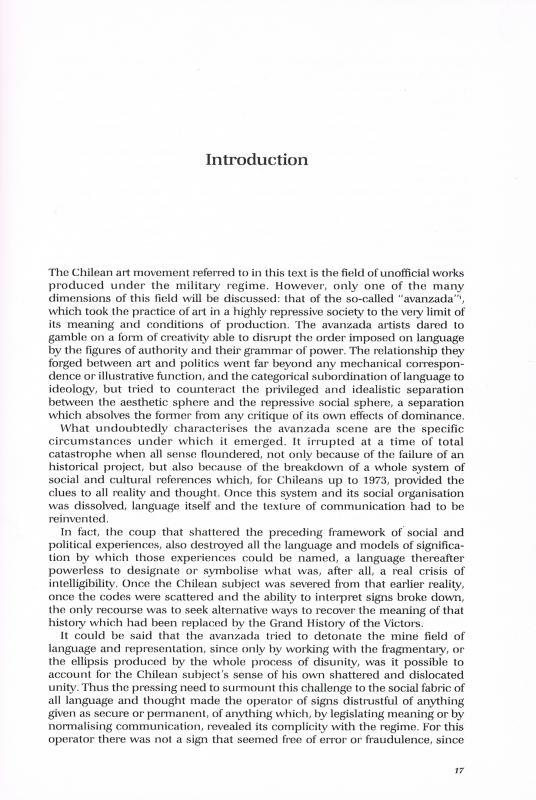The Seminario Arte Actual, coordinated by the theorist and cultural critic Nelly Richard (b. 1948) and presented at the Instituto Chileno-Norteamericano de Cultura, was a landmark event in the local art field at the time, which created a space devoted to the teaching and discussion of art production from a theoretical-critical perspective. As expressed here, traditional art was challenged by El Perchero [The Clothes Rack] (1975), a work by Carlos Leppe (1952–2015) that was exhibited as part of “Senografía,” the sculpture competition organized by the Galería Módulos y Formas. Leppe’s performance and installation piece consisted of three photographs, folded over hangers suspended from a clothes rack, each of which showed Leppe wearing a dress that exposed his breasts and/or patches on his breasts and genitals. Each photograph was folded in half over a hanger so that viewers were obliged to walk around the rack to see the rest of the image. Another piece that attracted attention was Autorretrato con hilos [Self-portrait with Threads] (1975), a manipulated photograph of Leppe that was part of Reconstitución de escena, the exhibition presented at the Galería Cromo two years later. In both of these works the body is an essential part of the piece.
In 1981 Richard published “Una mirada sobre el arte en Chile” [An Overview of Chilean Art] [see the ICAA Digital Archive (doc. no. 730121)] in which she discussed some of the subjects covered at the seminar and mentioned specific events as part of a reading of neo-avant-garde art. That text was a forerunner to Margins and Institutions. Art in Chile Since 1973 (doc. no. 738523)—the book in which she introduced the umbrella term Escena de Avanzada—which was originally published in Australia (1986) and presented the following year at Arte en Chile desde 1973. Escena de Avanzada y sociedad, the seminar organized by FLACSO (Facultad Latinoamericana de Ciencia Sociales), Galería Visuala, and Francisco Zegers Editor. That event was yet another forum devoted to the discussion about what had happened to art production over the course of almost a decade. [For more information on this seminar, see “Campo artístico, escena de avanzada y autoritarismo en Chile” (doc. no. 738628) by José Joaquín Brunner; “La escritura crítica y su efecto: una reflexión preliminar” (doc. no. 738636) by Adriana Valdés; and “A propósito de ‘Margins and Institutions’ y en el propósito de distanciamiento de su provocación y recorte: una extensión, una opción” (doc. no. 738632) by Francisco Brugnoli].
It is important to note the distance created by the experimental works that were produced prior to the fascist coup d’état in 1973; one of the criticisms of the Escena de Avanzada is that the movement took advantage of the break or disruption created by the dictatorship to distance itself from earlier experimental practices. Working on his own, Juan Pablo Langlois Vicuña (1936–2019), the artist mentioned here, produced various works that reflected a precarious materiality. [For more information about his work, see “Una cabeza con caparazón. Anotaciones sobre la obra de Vicuña” (doc. no. 756912) by Roberto Merino.]






